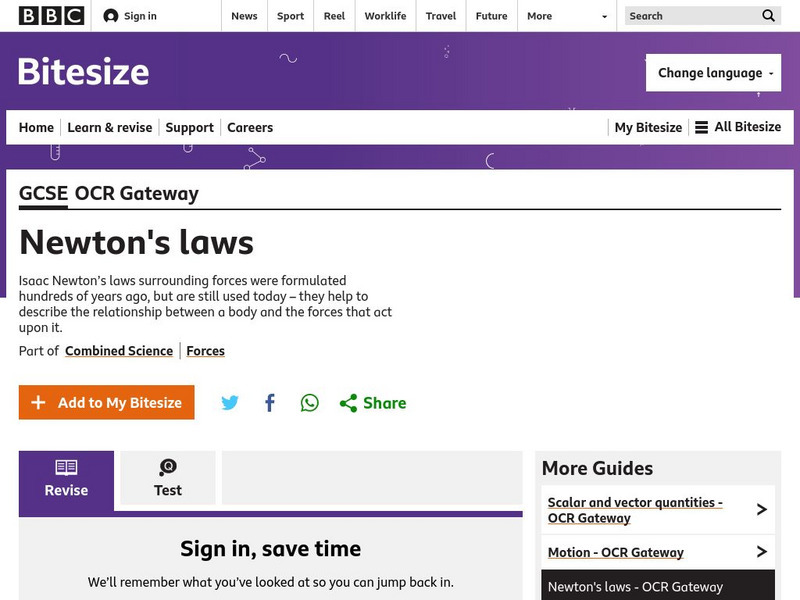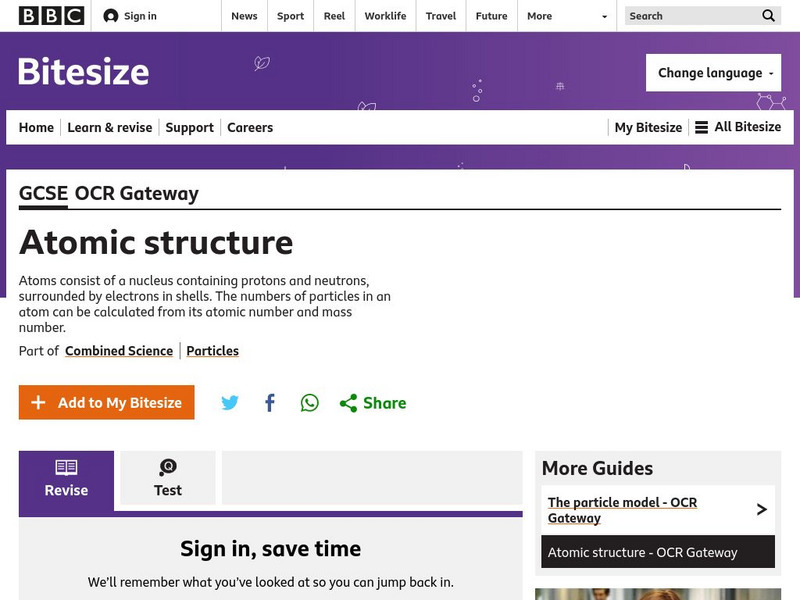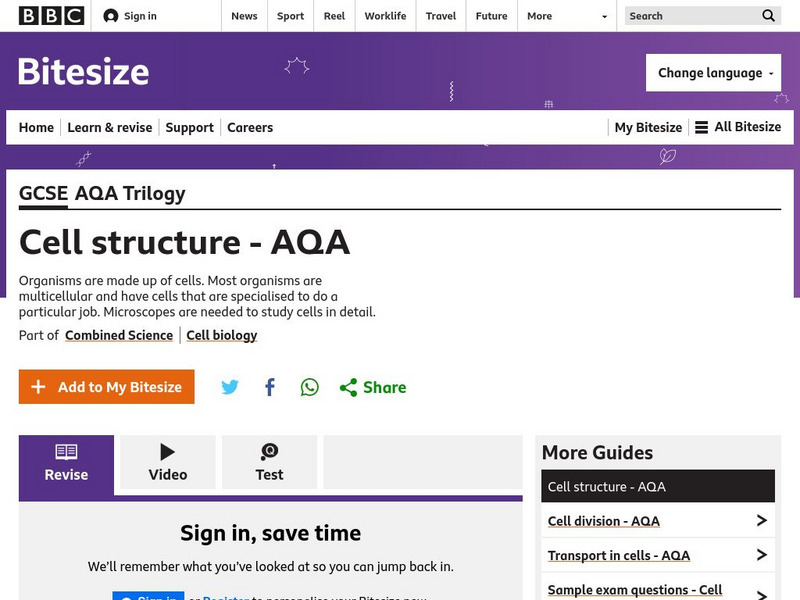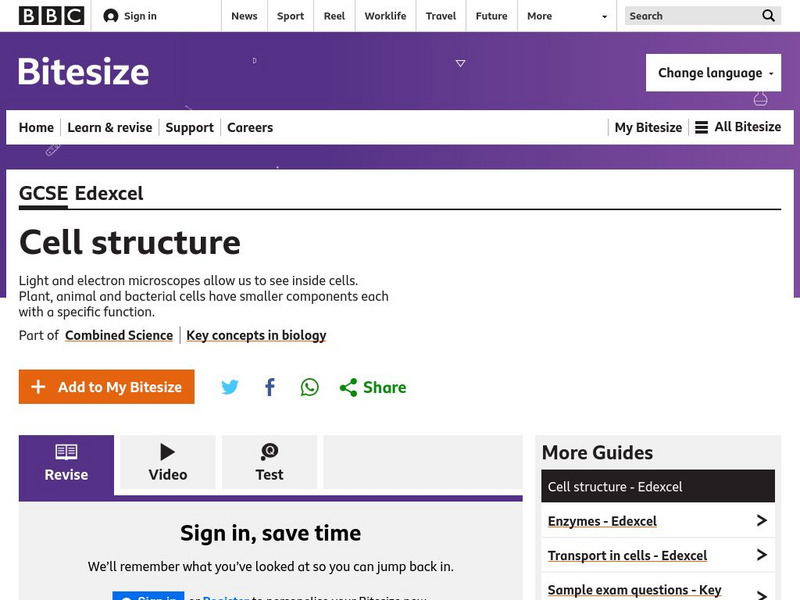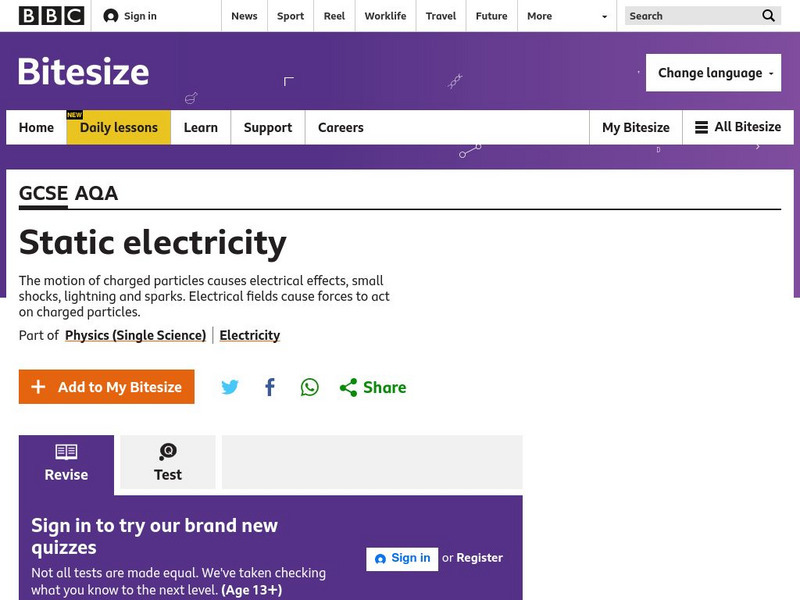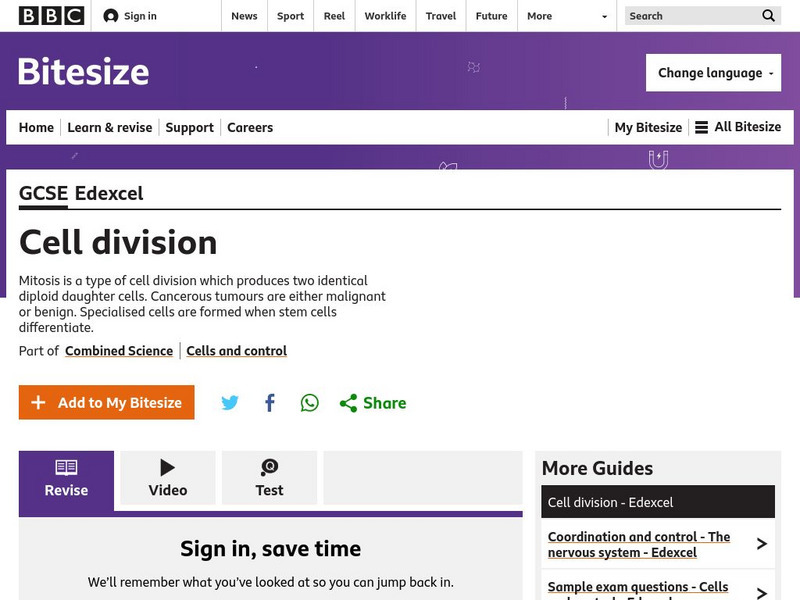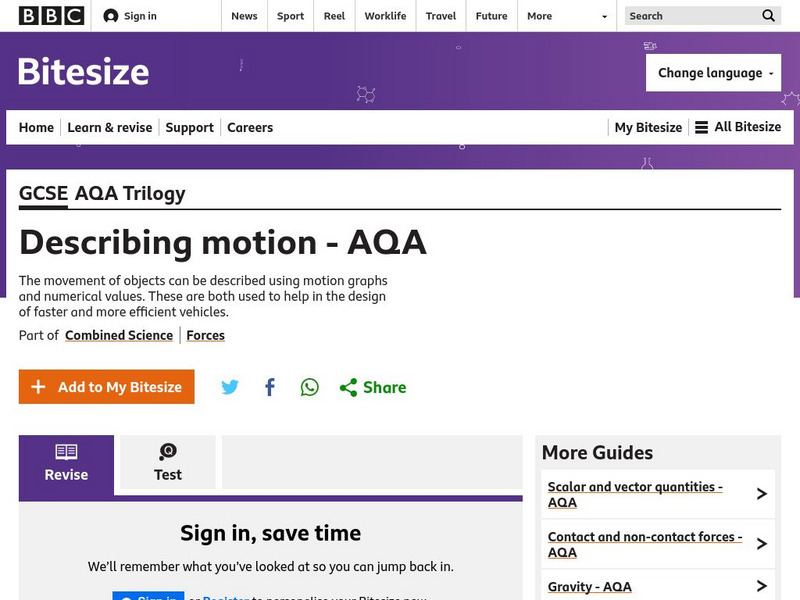BBC
Bbc: Gcse Bitesize: Newton's Laws
This lesson focuses on Newton's Law for falling objects including terminal velocity, the three stages of falling, a diagram showing what happens to the speed of a skydiver from airplane to ground, velocity-time graphs for falling...
BBC
Bbc: Gcse Bitesize: Reproduction, the Genome and Gene Expression
This lesson focuses on how genes, sections of the DNA, are formed including descriptions of transcription and translation. It provides links to a video and a test.
BBC
Bbc: Gcse Bitesize: Atomic Structure
This lesson focuses on the structure of atoms. All substances are made from atoms. Each atom is made of a nucleus - containing protons and neutrons - surrounded by electrons. It provides a link to an assessment.
BBC
Bbc: Gcse Bitesize: Motion
This lesson focuses on how to calculate average speed and distance traveled. It also explains how to convert different units of measure and provides a link to an assessment.
BBC
Bbc: Gcse Bitesize: Monitoring Chemical Reactions
This lesson focuses on percentage yield including what it is, the formula for calculating percentage yield, a sample calculation, and a link to a test.
BBC
Bbc: Gcse Bitesize: How Does the Nervous System Help Us Respond? Ocr 21 C
This lesson focuses on the areas of the brain and the functions of each area. It includes a diagram of the brain with areas labeled, a table of the functions of the areas, and a link to a test.
BBC
Bbc: Gcse Bitesize: Cell Structure Aqa
This lesson focuses on structures in a animal cell and their functions. It also provides links to a video and a test.
BBC
Bbc: Gcse Bitesize: How Can We Treat Disease? Ocr 21 C
This lesson focuses on Antibiotics including what they are, how they work, and antibiotic resistance. It also briefly discusses pain killers and viral diseases; it also provides a link to a test.
BBC
Bbc: Gcse Bitesize: Cell Structure
This lesson focuses on bacteria cells including their structures and functions, cell structures in common with bacteria, plants and animals, and a comparison between Eukaryotic and prokaryotic cells. It also provides links to a video and...
BBC
Bbc: Gcse Bitesize: Static Electricity
This lesson focuses on static electricity, including how particles can be charged by friction, and electrical forces and why they repel or attract each other. Includes a link to a test.
BBC
Bbc: Gcse Bitesize: Photosynthesis
This lesson focuses on photosynthesis including what it is, the word and symbol equations for photosynthesis, how it works, and how the extra glucose is used. It also offers links to a video and a test.
BBC
Bbc: Gcse Bitesize: Mass, Weight and Gravitational Field Strength
This lesson focuses on gravitational fields and includes what one is, the formula for gravity force, defining weight, formula for mass, an example of how to calculate gravity force, a practice question, and a link to a test.
BBC
Bbc: Gcse Bitesize: Cell Division
This lesson focuses on cell division including how chromosomes are formed from DNA, how many chromosomes there are in the human body, and diagrams of cell division. It also provides links to a video and a test.
BBC
Bbc: Gcse Bitesize: Uses and Dangers of Radiation
This lesson focuses on radiation including background radiation, natural and man-made sources of radiation, how to measure amounts of radiation, examples of doses of radiation and a link to a test.
BBC
Bbc: Gcse Bitesize: Electric Circuits Aqa
This lesson focuses on Electrical circuits including standard symbols for electrical components, a list of components and what they do, a discussion of various types of resistors, and alternating current and direct current. Links to a...
BBC
Bbc: Gcse Bitesize: Mains Electricity and Alternating Current Aqa
This lesson focuses on Mains Electricity and Alternating Current. Electrical supplies can be direct current (DC) or alternating current (AC). The UK mains electricity supply is about 230V at 50 Hz. It explains the difference between AC...
BBC
Bbc: Gcse Bitesize: Describing Motion Aqa
This lesson focuses on Distance-time graphs; the gradient of a distance-time graph represents the speed of an object.
BBC
Bbc: Gcse Bitesize: Radioactive Emissions
This lesson focuses on radioactive emissions including radioactive decay, half-life, using half-life, how to calculate net decline, a table showing how the count rate of an isotope might change over time, and a link to a test.
BBC
Bbc: Gcse Bitesize: Predicting Chemical Reactions
This lesson focuses on the physical properties of halogens, Group 7 elements on the Periodic Table. It includes the physical properties of the elements, provides a graph showing the melting and boiling points of the halogens, and links...
BBC
Bbc: Gcse Bitesize: Science
This site provides links to exams for four science courses by Bitesize: GCSE Biology, GCSE Chemistry, GCSE Combined Science, and GCSE Physics.
BBC
Bbc: Gcse Bitesize: Acids, Alkalis and Salts Aqa
This lesson focuses on acids and alkalis including acidic and alkaline solutions, neutral solutions, indicators and the pH scale, the colors for litmus paper, and a link to a test.
BBC
Bbc: Gcse Bitesize: Genetic Inheritance Aqa
This lesson focuses on genetic key terms; it defines them and explains what they do. It provides links to a video and a test.
BBC
Bbc: Gcse Bitesize: Animal Organization Digestion Aqa
This lesson focuses on the structures of carbohydrates, proteins, and lipids including defining terms, a brief discussion of what they do, and diagrams of each. It also provides a link to a test.
BBC
Bbc: Gcse Bitesize: The Life Cycle of a Star
This lesson focuses on the formation and life cycle of stars. Stars form when enough dust and gas clump together because of gravitational forces. Nuclear reactions release energy to keep the star hot. Some stars grow larger over time....


